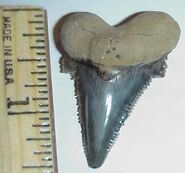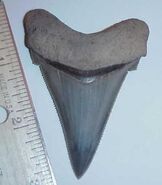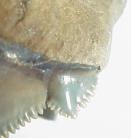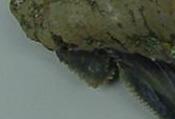Carcharocles angustidens and Carcharocles auriculatus are two species weren't separated by that much geologic time, they were directly related, they lived in the similar locations, they ate similar prey, and they grew to similar sizes.
Location[]
The only way you can be completely sure a particular tooth is an C. auriculatus or an C. angustidens is if you know its origin. Furthermore, the location must only produce one species or the other. It is necessary to must rely on tooth features to make the determination in most cases. There are, however, a few locations where both of the aforementioned conditions are true. The Lafarge quarry in Harleyville, SC is an Eocene site that produces C. auriculatis teeth from a pristine layer called the green cap. There never have been nor will there ever will be C. angustidens teeth found at this location, so this article will use specimens from here to exemplify C. auriculatis. Likewise, "The Big Ditch" in Summerville, SC is an Oligocene site that produces angustidens teeth from a pristine layer called the Chandler Bridge. C. angustidens and not C. auriculatus teeth are found here so I will use this location to exemplify the Oligocene species in question.
Root[]
Root differences between C. angustidens and C. auriculatus.
Most often, the distinguishing factor between C. angustidens and C. auriculatis is the root.
Notice first the root lobes on the C. auriculatus. Both lobes are very rounded, almost circular in appearance. As a "ric" tooth's distance from the sympheseal line increases, it is not uncommon for the lobe adjacent to the distal edge to become more angular. However, the lobe adjacent to the mesial edge usually maintains its rounded appearance. Compare this to the C. angustidens. The ends of the lobes seem to be the apex of an angle formed between the centerline of the root and the root/blade boundary even at the lateral positions. As the "angy" increases in distance from the sympheseal joint, the root lobe adjacent to the distal edge becomes distinctly angular. Another feature that seems to be distinctly angustidens is the tendency of the root to "recurve". Notice the concave features just above where the root meets the blade.
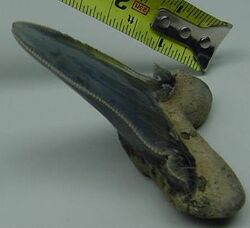
C. auriculatus specimen from the Lafarge quarry. Notice how it rests unaided on the root.
A final distinguishing feature is the presence of "ears". Notice on the C. angustidens the presence of the root structures that extend over the outside edge of the cusps. This trait is also shared by a species down the evolutionary chain, C. megalodon. Another distinguishing root characteristic is the tendency for C. auriculatus teeth to rest upright on their roots. This is undoubtedly due to the more robust nature of "ric" roots. Refer to figure 2.
Cusps[]
Whatever their purpose, the cusps serve as another way to distinguish C. auriculatus from C. angustidens. Refer to figure 3. On the left is a closeup of the cusp of an C. angustidens, and on the right is a closeup of the cusp of an C. auriculatus. Notice how the separation between cusp and blade is more pronounced in the C. auriculatus example. The cusp is more "independent" of the blade than the cusp on the C. angustidens, which shares more enamel at its inner base. I have seen specimens of C. auriculatus where the cusps are completely separated from the blade. In some C. angustidens, the blade and cusps seem to "fold" together.
Cusps differences between C. angustidens and C. auriculatus.
